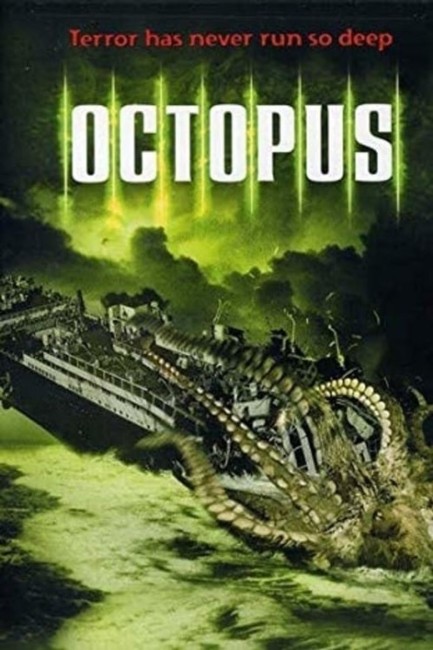USA. 2000.
Crew
Director – John Eyres, Screenplay – Michael D. Weiss, Story – Boaz Davidson, Producers – Boaz Davidson, Danny Lerner & David Vardo, Photography – Adolfo Bartoli, Music – Marco Marinangeli, Digital Visual Effects – Magic Camera Company Limited (Supervisor – Mark Harris), Special Effects Supervisor/Puppet Design – Willie Botha, Production Design – Carlos DaSilva. Production Company – Nu Image/Martian Holding A.V.V.
Cast
Jay Harrington (Agent Roy Turner), Carolyn Lowery (Dr Lisa Finch), David Beecroft (Captain Jack Shaw), Ravil Isyanov (Casper), Ricco Ross (Brickman), Jeff Nuttall (Henry Campbell)
Plot
Novice CIA field agent Roy Turner apprehends the terrorist Casper after Casper detonates a bomb at the US embassy in Bulgaria. The American authorities want Casper brought to the US with great haste and so Turner is put aboard the US Navy submarine Roosevelt under the maverick Captain Jack Shaw. As the submarine sets sail, they are attacked by something under the water. Lisa Finch, a marine biologist who also happens to be aboard, realizes that their attacker is an octopus that has been mutated to giant-size by toxic waste leaked from a Russian submarine that was sunken during the Cuban Missile Crisis. With the submarine damaged by the octopus’s attacks and with only a short time before its’ nuclear reactor explodes, Casper escapes custody and tries to rendezvous with a cruise liner that his people have taken over on the surface above.
John Eyres is a director down the B-budget end of the market where he specializes in science-fiction and horror films that are usually also action hybrids. Eyres has also been responsible for some of the silliest genre films ever made. Eyres’ works include the likes of Project: Shadowchaser (1992) and its two sequels, Project Shadowchaser II (1995) and Project Shadowchaser III (1995), as well as the likes of Monolith (1994), Judge and Jury (1996) and Ripper: Letter from Hell (2001). Eyres pays scanty attention to basic things such as plausibility and his films often have some of the wackiest premises imaginable – the Project Shadowchaser films with their android terrorists, or Judge and Jury with an outrageously overacting undead Keith David pursuing Martin Kove.
Octopus is clearly an effort upon John Eyres’s part to jump aboard the CGI monster trend that emerged after Jurassic Park (1993). There were a good many other CGI monster movies that came out in the wake of Jurassic Park, including well-budgeted efforts such as Loch Ness (1996) to Anaconda (1997), Deep Rising (1998), Godzilla (1998), Mighty Joe Young (1998), Bats (1999), Lake Placid (1999), Eight Legged Freaks (2002), King Kong (2005) and Snakes on a Plane (2006), and an increasing horde of cheap B-budget efforts such as King Cobra (1999), Komodo (1999), Crocodile (2000), Python (2000), Spiders (2000), Fangs (2001), New Alcatraz/Boa (2002), Attack of the Sabretooth (2005), Cerberus (2005), Larva (2005), Mansquito (2005), Pterodactyl (2005), Kraken: Tentacles of the Deep (2006), Mammoth (2006) and Minotaur (2006) and numerous others. Production company Nu Image have been especially prolific at producing these cheap CGI monster movies.
Octopus emerges as a B-budget CGI monster movie. Moreover, the giant title creature forms a relatively minor threat compared to the main action. The film was clearly made with only an impoverished effects budget and so the octopus is only occasionally seen attacking the submarine in a series of exterior cuts, while there is only a single scene where a giant tentacle bursts into the sub. More importantly, the giant octopus never attains a particular threat in the way that say the shark in Jaws (1975) was an ever-present menace that seemed constantly on the verge of unexpectedly erupting out of the corner of the frame.
The majority of Octopus is taken up by the submarine-board drama. It is almost as though John Eyres has conceived the film as a mix of Jaws and Crimson Tide (1995) – or more accurately in the vein of B-budget submarines dramas like Crash Dive (1996), Sub Down (1997) and Submerged (2001). Here the film is only notable for the ridiculous collusions that John Eyres and scriptwriter Michael D. Weiss throw together.
The characters are an absurd assortment of clichés and improbabilities – the rookie FBI agent placed in sole charge of escorting a dangerous terrorist; the token woman on board the sub (who conveniently also happens to be a marine biologist and able to explain the nature of the menace); the dangerous criminal who manages to affect an escape while being transported and then attempts to take over the ship; and a series of scenes with the monster of the show attacking people aboard an ocean-going cruise liner, which seem to have been copied from Deep Rising.
The villain’s escape plan is particularly notable for its ludicrous implausibilities – his cohorts infiltrate and take over a cruise liner on the apparent belief that he will somehow be able to escape confinement in the submarine just at the point when they happen to be right above, despite their having no tracking equipment or he any means to communicate with them on his person; while his actual escape involves freeing himself from his cuffs by dislocating his wrist and then putting the wrist back into place with his teeth. The film’s ludicrous improbabilities are surely first observed early on when the hero rendezvouses with the submarine for his transatlantic voyage where the submarine is clearly seen surfacing inside a lake!!!
The sequel was Octopus II/Octopus 2: River of Fear (2001), which relocated the central menace to New York but was unrelated to this film other than featuring a similar giant title threat.
(Winner in this site’s Worst Films of 2000 list).
Trailer here

